DGA 2020-2025 Survey and Focus Group (English and Spanish)
Generic Clearance to Conduct Formative Research/CNPP
Attachment C-2 Discussion Guide (English) clean OCIO 081120
DGA 2020-2025 Survey and Focus Group (English and Spanish)
OMB: 0584-0523
OMB CONTROL NO.: 0584-0523
EXPIRATION DATE: 11/30/2022
OMB BURDEN STATEMENT: According to the Paperwork Reduction Act of 1995, no persons are required to respond to a collection of information unless it displays a valid OMB control number. The valid OMB control number for this information collection is 0584-0523 and the expiration date is 11/30/2022. The time to complete this information collection is estimated at 2 hours, including 30 minutes for logging into the online platform, reviewing instructions, and completing the information. Send comments regarding this burden estimate or any other aspect of this collection of information, including suggestions for reducing this burden, to: U.S. Department of Agriculture, Food and Nutrition Services, Braddock Metro Center II, 1320 Braddock Place, Alexandria, VA 22314, ATTN: PRA (0584-0523). Do not return the completed form to this address.
Attachment C-2 Discussion Guide (English)
(B-24 Caregiver Audience)
Focus Group Moderator Guide
Target Time ≈ 2 hours (including 30 minutes to log on)
Introduction (10 minutes]
Moderator introduces him/herself
Remind respondents to be in a quiet place
If you need to step away, do so briefly and come back as soon as possible
Anonymity
Rules for participation online (all opinions count, no wrong answers)
One point you may notice about everyone participating today is that everyone has a child who is 24 months old or younger. We will talk about what that’s like in a few different areas of the discussion, and even though that is the case, we all do not have to agree, nor do we have to find consensus. Please share your honest thoughts and impressions.
Grab a few pieces of paper and a pen or pencil.
Introduction – Share your first name, where you live, with whom you live (people, pets, plants, etc.), and what if anything you had for breakfast today.
Warm-Up & Food Decision-Making for the Parent/Caregiver (5-10 minutes)
To start, take a moment and think of a word or phrase you would use to describe what life is like these days.
[MODERATOR GO AROUND SCREEN]
Why that word or phrase?
We are going to make a list. I am going to give you a word, and I want you to type all of the words and phrases that come to mind when I say that word. We’ll have about 30 seconds to type our words and phrases into the chat box. What are the words and phrases that come to mind when I say, “healthy eating”?
[MODERATOR TO ALLOW UNAIDED RESPONSE]
[GO AROUND SCREEN:] What were the first few words/phrases that came to your mind? Why those?
When, if at all, do you think about healthy eating?
How much, if at all, do you think about healthy eating when it comes to the foods you choose to eat?
How does that compare with the thought you give to beverages you drink during a day? [PROBE: more/less likely to do so food vs beverage; or at different times of the day]
Food Decision-Making for the 0-24-Month-Old (25 minutes)
What if I altered the question to ask about how much, if at all, you think about healthy eating when it comes to the foods and beverages…
[0-6 GROUP] …you give your baby?
[6-12 GROUP] …you give your baby?
[12-24 GROUP] …you give your toddler?
If nothing, why not? [PROBE: age of child; limited foods child receives]
Is this something you think about more or less for your [baby/toddler] than yourself? What makes you say that?
[0-6 GROUP & 6-12 GROUP] Raise your hand if your baby eats foods beyond breast milk or formula. TAKE HAND COUNT
[IF NO:] What are the reasons why you have decided to only give your baby breast milk or formula to this point?
[IF NO:] What foods do you think you will introduce first?
[IF YES:] When did you first introduce food beyond breast milk or formula?
[IF YES:] What foods did you introduce first?
[IF YES:] What made you decide to introduce food beyond breast milk or formula?
[12-24 GROUP] At what age did you first introduce food beyond breast milk or formula?
What made you decide to start then?
Did you have an age in mind when you wanted to start introducing foods? If so, did you meet that target?
What foods did you introduce first? Then what?
At what age of a child does it start getting really important for parents to focus on the nutrition of/how healthy what the child is eating/drinking is, if at all? Why then? What makes that time different than other times?
[6-12 GROUP & 12-24 GROUP] Now a different question, on a scale of 1 to 5, where a 1 means it is very easy, and a 5 means it is very difficult, and you can use any number from 1 to 5, how easy/difficult is it to make sure that your [baby/toddler] eats/drinks foods and beverages that are healthy?
GO AROUND SCREEN
What makes you say that?
What’s difficult? What are the harder parts about making sure your child eats/drinks foods and beverages that are healthy? [PROBE: Changing information/information sources]
What specific elements of what your child eats and drinks are you most concerned about?
[IF NECESSARY:] In other words, what are some things, if any, you want to make sure your child gets enough of?
[IF NECESSARY:] What are some things, if any, that you want to limit?
Currently, where do you get this information about what your child should eat and drink?
How do you get this information? How often?
Which websites, Apps, or devices help you?
HANDCOUNT: How many of you use the Amazon/Alexa App on some device?
What would you think about being able to say, “Alexa, give me information on nutrition for infants and toddlers”?
How helpful would that be to you, if at all?
What information would you hope to learn or would be most helpful to you?
Is this something you would try? What makes you say that?
I’m going to ask you about a few elements of foods/beverages, and I want to get your reactions. Again, there are no wrong answers, and we all do not have to agree. Take a look at the list on the screen. Let me know which 2 of the list below you are most concerned about when it comes [0-6 GROUP] to what your baby will eat/drink / [6-12 GROUP & 12-24 GROUP] to what your baby/toddler eats/drinks. Type them into the chat box.
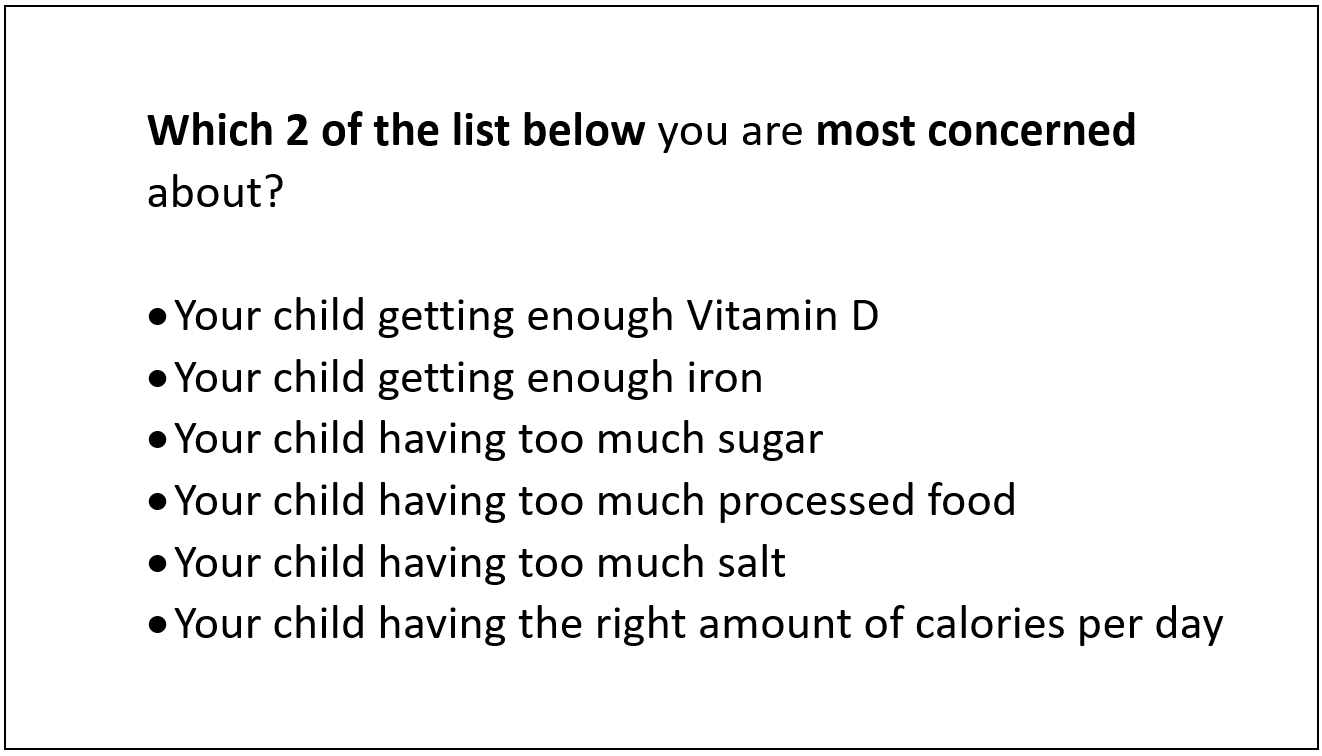
Language displayed on the computer screen during the focus group for participants to read and discuss.
Your child getting enough Vitamin D
Your child getting enough iron
Your child having too much sugar
Your child having too much processed food
Your child having too much salt
Your child having the right amount of calories per day
Now, we are going to talk about a few of the items on this list.
DISCUSS TOP CONCERNS AS TIME ALLOWS
ALWAYS FOLLOW UP ON “your child getting enough iron.”
What is the cause of that concern? [PROBE: Pediatrician/Dr/HCP? Other recommendations? Health issue?]
[TO THOSE WHO DID NOT SELECT IT:] Why did this one not make the list?
Is it important, just not as important as the ones you selected? How do you know it is important?
How would you find out if your child is getting enough iron?
ALWAYS FOLLOW UP ON “your child having too much sugar.”
TAKE HAND COUNT
What is the cause of that concern? [PROBE: Pediatrician/Dr/HCP? Other recommendations? Health issue?]
[TO THOSE WHO DID NOT SELECT IT:] Why did this one not make the list? Is it important, just not as important as the ones you selected? How do you know it is important?
How would you find out if your child is getting too much sugar?
Moving on. I am going to show you two statements on the screen, and I want to get your reactions.

Language displayed on the computer screen during the focus group for participants to read and discuss.
The first one is, “Foods under Age 1 are just for fun.” Do you agree/disagree with this statement? What makes you say that?
The second one is, “Research shows there is a large increase in the amount of sugar consumed by children when they reach 1 year of age.”
What is your reaction to this statement?
What do you think is the cause? [PROBE: Sugar-sweetened fruit juices, sweet snacks]
[12-24 GROUP] Was/is that your experience? What caused the change once your child reached 1 year of age?
Nutrition Trajectory (5-10 minutes)
Let’s shift gears. Earlier, we talked about how much you think about healthy eating. When you think about your approach to healthy eating, is it something that has pretty much been the same or has it changed over time?
In other words, have there been times in your life when you were more focused on healthy eating than you are now?
[IF YES:] When were those times?
[IF YES:] What about those times made you more focused on healthy eating?
[IF NO:] Why do you think that is?
[IF TIME:] Have there been times in your life when you were less focused on healthy eating than you are now?
[IF YES:] When were those times?
[IF YES:] What changed? What about those times made you less focused on healthy eating?
[IF NO:] Why do you think that is?
Have you ever thought about healthy eating in this way, over the course of your lifetime?
How important is it to think about it in this way? What makes you say that?
Let’s think about your baby/toddler for a moment. How important is it to think about your child’s nutrition over time?
Do you think anything can be done now to get your child on a positive track or healthy path? What makes you say that?
What can be done?
What, if anything, can you do to help give your baby/toddler a healthy start?
Or, does it even matter now? What makes you say that?
Language/Concept Testing (25 minutes)
A. Thanks for that
information. Now, we’re going to look at a few different
sentences, and I want to get your reactions and interpretations of
the information in each sentence.
MODERATOR WILL ROTATE SENTENCES ACROSS GROUPS TO GET REACTIONS AND TEST TWO PER GROUP. THE VARIETY SENTENCE MUST BE ASKED IN EACH GROUP.
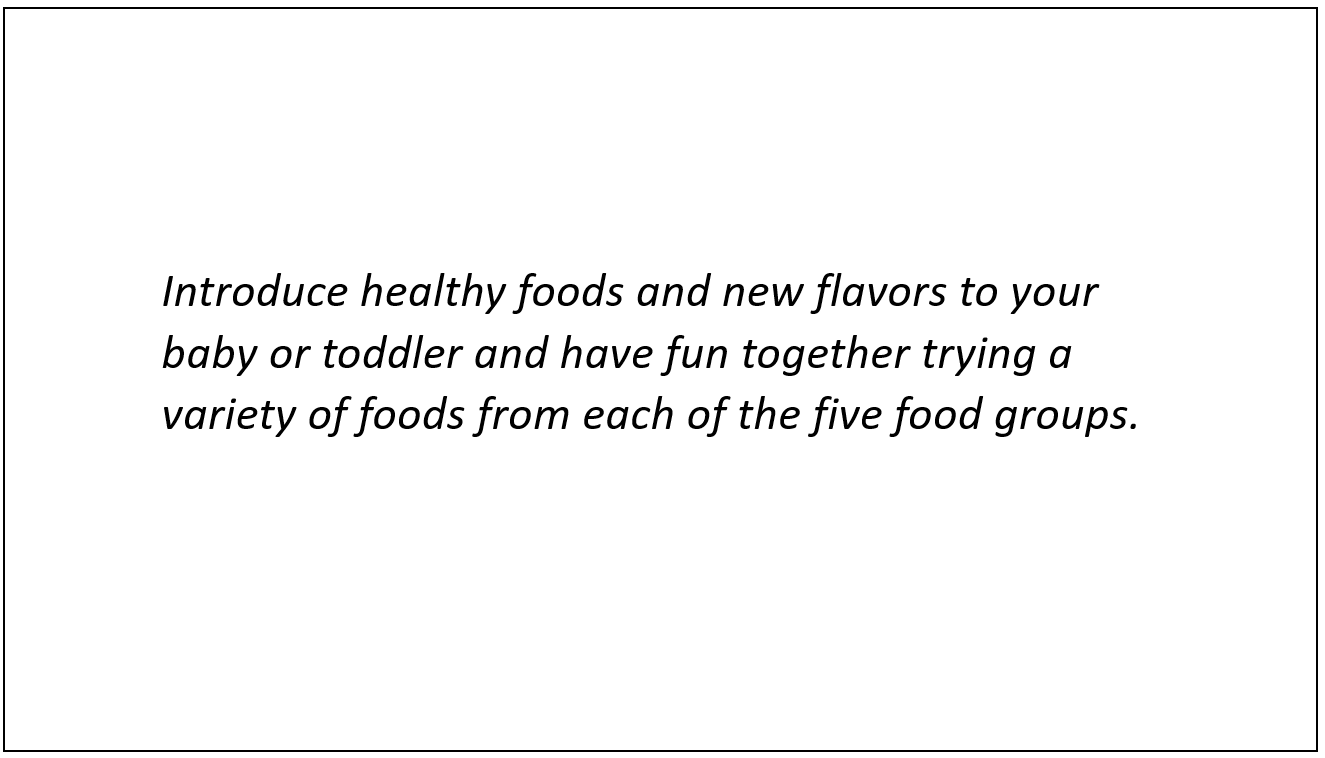
Language displayed on the computer screen during the focus group for participants to read and discuss.
“Introduce healthy foods and new flavors to your baby or toddler and have fun together trying a variety of foods from each of the five food groups.”
What is this sentence asking you to do?
In your own words, what does it mean to “try a variety of foods from each of the five food groups”?
What does “variety” mean in this context?
On a scale of 1 to 5, where a 1 means it is very easy, and a 5 means it is very difficult, and you can use any number from 1 to 5, how easy/difficult would it be to do what this sentence suggests? GET TALLY
What makes you say that?
What do you think would be the most challenging part?
[PROBE:] Eating from new food groups
[PROBE:] Eating more than you normally eat
This sentence also uses the term, “food groups.”
Are you familiar with the term?
Is it a term you still use?
Does it make sense to use the term, “food groups,” when talking about foods for a baby/toddler? What makes you say that?
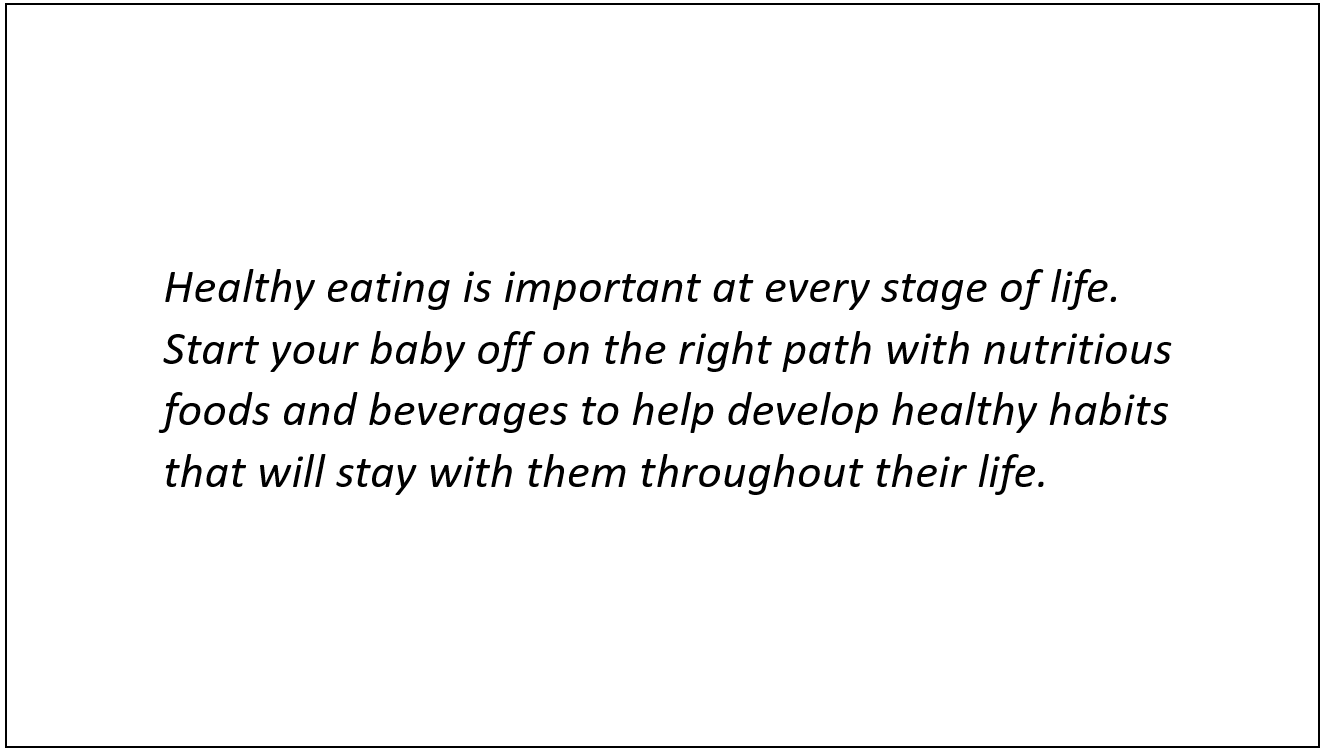
Language displayed on the computer screen during the focus group for participants to read and discuss.
“Healthy eating is important at every stage of life. Start your baby off on the right path with nutritious foods and beverages to help develop healthy habits that will stay with them throughout their life.”
What is your first reactions to these sentences?
Do you agree/disagree? What makes you say that?
Are they believable? What makes you say that?
How important is it to think this way about what your baby/toddler eats and drinks? How does it make you feel as a parent?
What do you think about the phrase, “every stage of life”?
What, if anything, do you find confusing about that phrase?
What “life stage” would you say you are in right now?

Language displayed on the computer screen during the focus group for participants to read and discuss.
“What your baby eats and drinks today can impact your baby’s health now and in the future. Every bite counts.”
What is your first reactions to these sentences?
Do you agree/disagree? What makes you say that?
Are they believable? What makes you say that?
How important is it to think this way about what your baby/toddler eats and drinks? How does it make you feel?
What do you think about the phrase, “every bite counts”?
How does that phrase make you feel as a parent?
Dietary Guidelines Message Drill-Down and Icon Review (15 minutes)
A. Now we are going to
talk about something a bit more specific. I am going to show you
some recommendations that are going to be part of the 2020
Dietary Guidelines for Americans.
The Dietary
Guidelines for Americans
are our nation’s national food and nutrition recommendations.
They tell us what people should eat and drink every day to be
healthy.
Have any of you heard of the Dietary Guidelines for Americans?
What about MyPlate.gov?
[SHOW MYPLATE LOGO ON SCREEN AND ASK AGAIN]
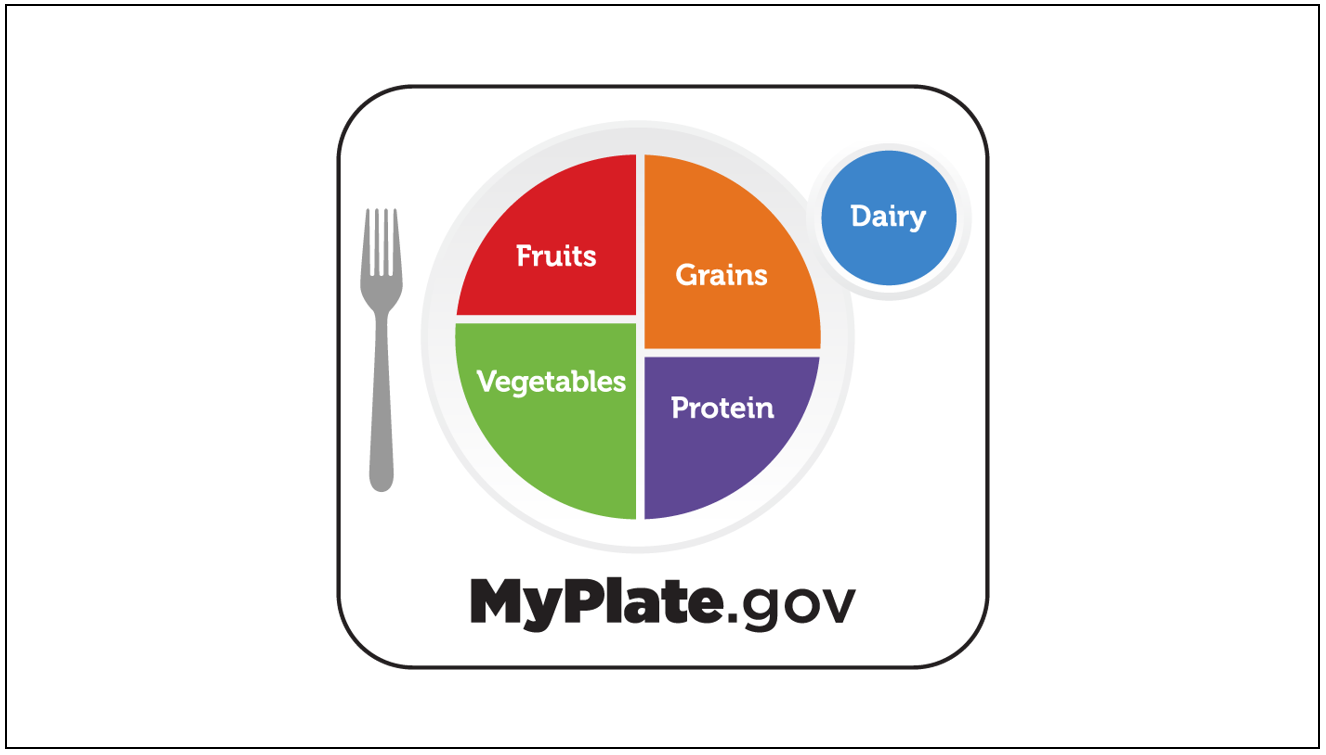
Image displayed on the computer screen during the focus group for participants to read and discuss.
The information in MyPlate incorporates the recommendations in the Dietary Guidelines.
Take look at the screen, and you will see a list of recommendations for children 0-24 months. Take a moment, and on your scratch sheet of paper write down anything that jumps out at you in a positive or negative way. Also write down anything that seems confusing. Then, we’ll talk about it. [SHOW RECOMMENDATIONS ON SCREEN]
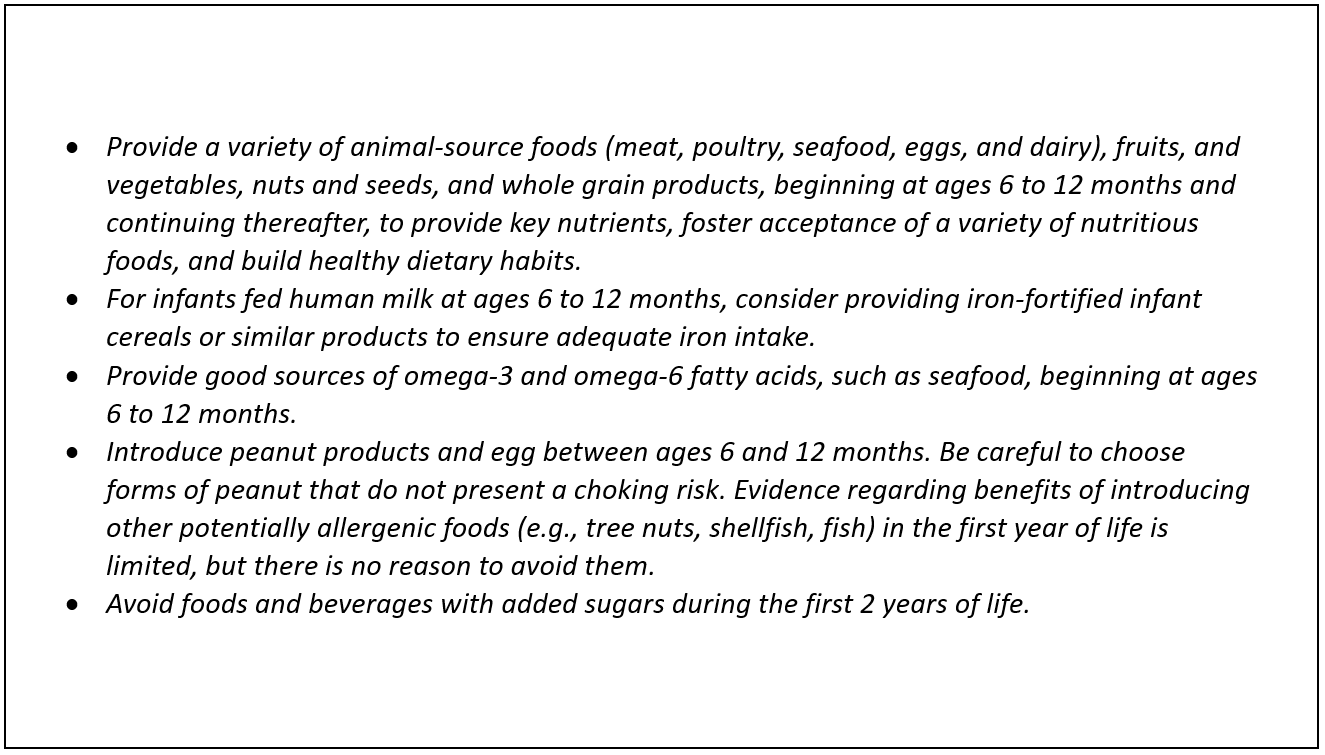
Language
displayed on the computer screen during the focus group for
participants to read and discuss.
Provide a variety of animal-source foods (meat, poultry, seafood, eggs, and dairy), fruits, and vegetables, nuts and seeds, and whole grain products, beginning at ages 6 to 12 months and continuing thereafter, to provide key nutrients, foster acceptance of a variety of nutritious foods, and build healthy dietary habits.
For infants fed human milk at ages 6 to 12 months, consider providing iron-fortified infant cereals or similar products to ensure adequate iron intake.
Provide good sources of omega-3 and omega-6 fatty acids, such as seafood, beginning at ages 6 to 12 months.
Introduce peanut products and egg between ages 6 and 12 months. Be careful to choose forms of peanut that do not present a choking risk. Evidence regarding benefits of introducing other potentially allergenic foods (e.g., tree nuts, shellfish, fish) in the first year of life is limited, but there is no reason to avoid them.
Avoid foods and beverages with added sugars during the first 2 years of life.
What is your reaction to this information?
What, if anything, did you have a positive reaction to? Why?
What, if anything, did you have a negative reaction to? What, specifically, caused that reaction?
What, if anything, seems confusing?
What, if anything, seems different from what you have heard/read elsewhere?
Of the ones that are listed there, which one would be the hardest for you to do? What makes that one the hardest? What would help you achieve this “hard” recommendation?
MODERATOR, AS TIME ALLOWS AND IF NOT PREVIOUSLY MENTIONED, PROBE ON THE FOLLOWING:
One of the recommendations suggests “iron-fortified infant cereals or similar products.”
What are some examples of these products?
Is this new information, or have you heard it before now? From where?
Another recommends “avoiding foods and beverages with added sugars during the first 2 years of life.”
What is your reaction to this recommendation?
How likely are you to try to follow this recommendation? What makes you say that?
Is this new information, or have you heard it before now? From where?
What do you think about the recommendations about when to introduce certain foods (e.g., peanut products, animal-source foods)?
How likely are you to try to follow these recommendations? [ASK ABOUT PEANUT VS. ANIMAL SEPARATELY] What makes you say that?
Is this new information, or have you heard it before now? From where?
Earlier, I mentioned that MyPlate.gov incorporates the Dietary Guidelines. This year represents the first time the Dietary Guidelines is including recommendations for babies and toddlers 0-24-months in age. As a result, MyPlate is considering an additional logo to represent this information, specifically. Take a look at the screen. It includes an idea for the logo. It is not finished. It was just designed for this conversation.
SHOW LOGO ON SCREEN
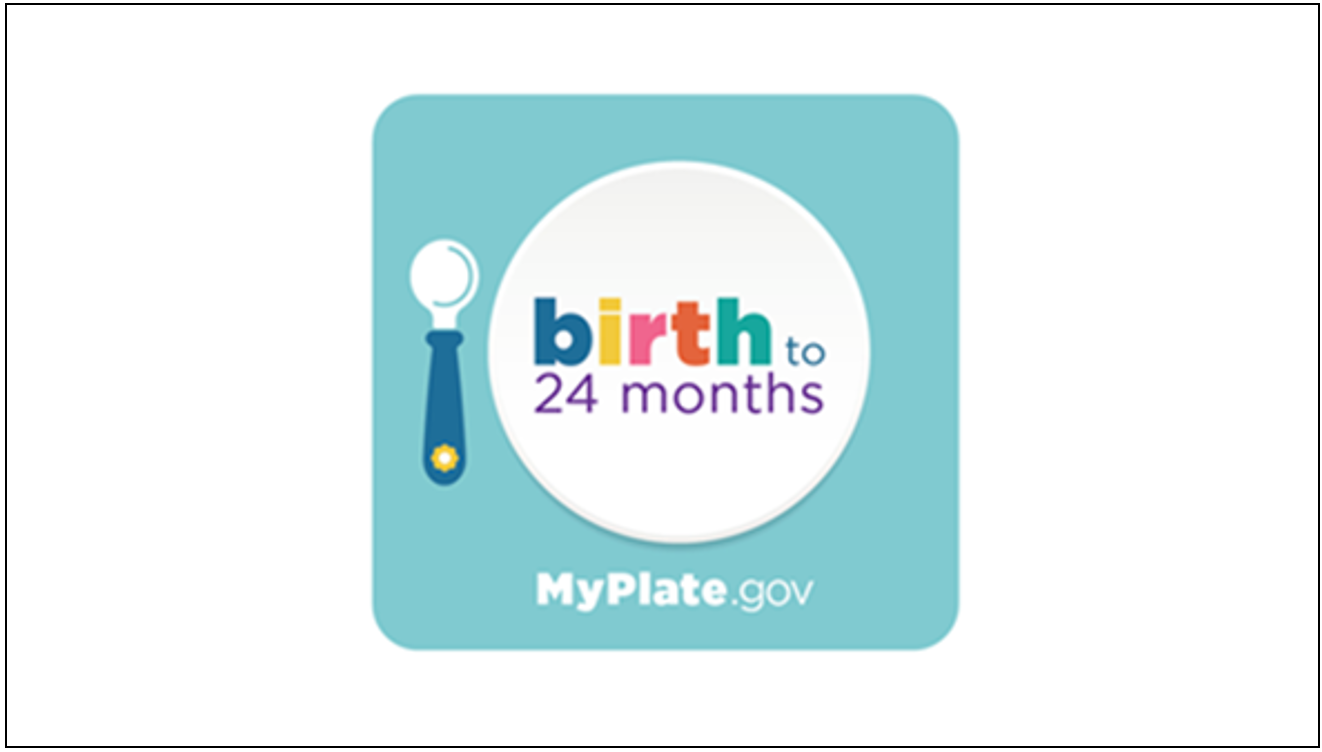
Image displayed on the computer screen during the focus group for participants to read and discuss.
What is your initial reaction? What is the tone or feeling you get?
What do you like about the logo?
What do you dislike?
To what extent, if at all, does it connect to MyPlate? What makes you say that?
What do you think about the name MyPlate, MyBaby?
Is it appropriate? What makes you say that?
Does it speak to you as something for you and your 0-24-month-old? What makes you say that?
What questions do you have?
…about the logo
…about what MyPlate, MyBaby will include
Reactions to Words and Phrases (5 minutes)
Before we end the group, I want to get your reactions to some language. This will be our “word association” round for quick feedback. I am going to give you a word, and I want you to give me the first word, phrase or image that comes to mind.
What does it mean when a food is “nutrient-dense”?
Is this a good thing or a bad thing?
By a show of hands, how many of you have heard the term, “nutrient density”?
What are some examples of foods or beverages that are nutrient-dense?
How do you know they are?
Does it seem like it would be easy or hard for you to make more nutrient-dense choices when deciding what to eat and drink?
What makes you say that?
How, if at all, do you think it would change the decisions you make about what to eat and drink?
[MODERATOR SHOW POLL ON SCREEN] On the screen, you will see three different phrases that could be used to communicate this idea. Which one would you be most likely to use—nutrient-dense; nutrient-packed; quality calories?
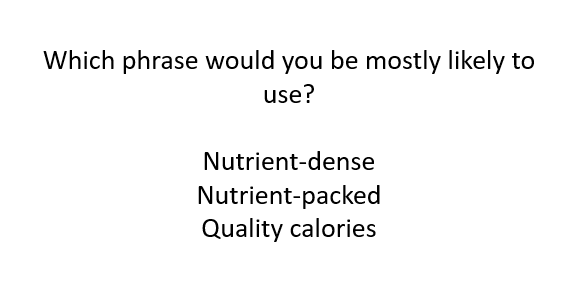
Language displayed on the computer screen during the focus group for participants to read and discuss.
ALLOW RESPONDENTS TO VOTE, SHARE TALLY
Wrap-up/False Close (5 minutes) – IF TIME
Thank you for all of the information you have provided. I am going to check with my colleagues to make sure they do not have any additional questions. While I do, please look at the statement on the screen and write an answer in the chat box.
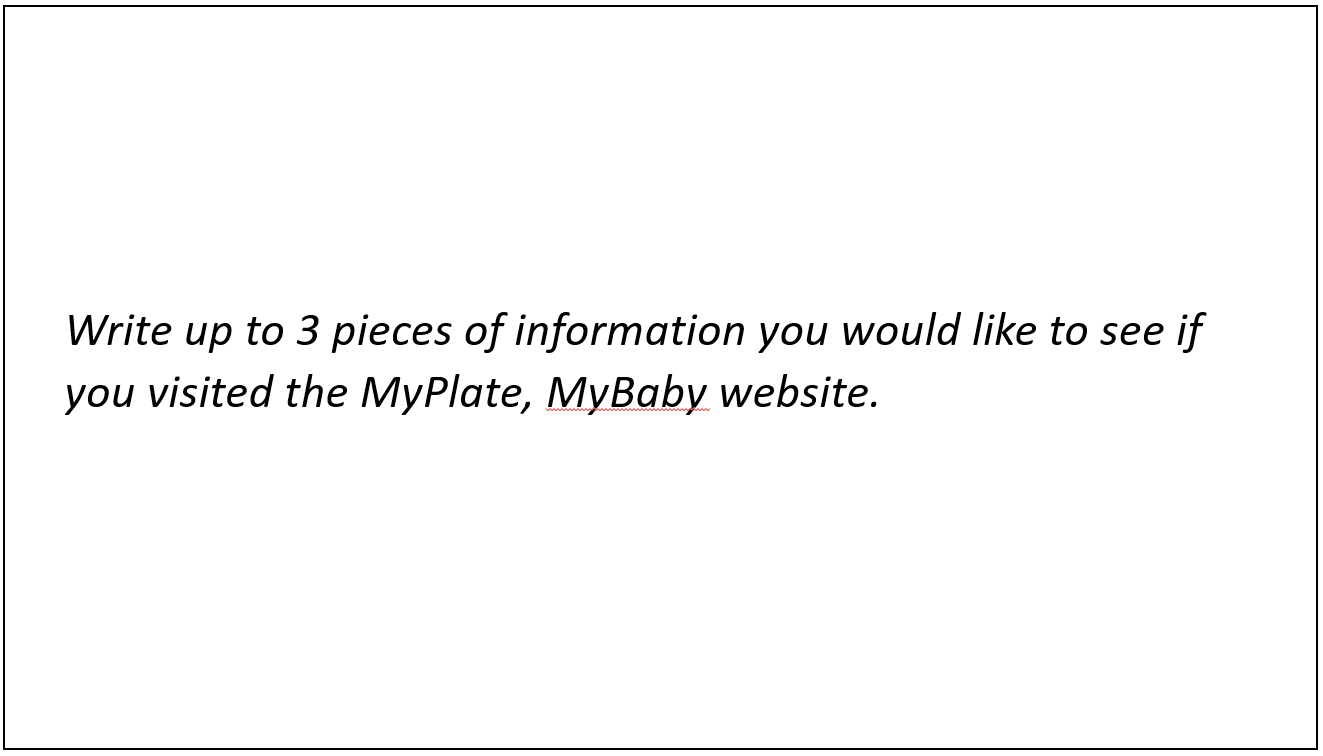
Language
displayed on the computer screen during the focus group for
participants to read and discuss.
Write up to 3 pieces of information you would like to see if you visited the MyPlate, MyBaby website.
Thanks again! Have a great evening.
Privacy Act Statement:
Legal Authority: The United States Department of Agriculture (USDA) Food and Nutrition Service (FNS) is authorized to collect this information under Section 19 of the Child Nutrition Act of 1966 (42 U.S.C. 1787), Section 5 of the Richard B. Russell National School Lunch Act (42 U.S.C. 1754) and Section 11(f) of the Food and Nutrition Act of 2008 (7 U.S.C.2020).
Purpose: This information will be used in to inform the 2020-2025 Dietary Guidelines for Americans about how Americans make food choices and think about health-related issues.
Routine Use: Information may be disclosed for any routine uses listed in the published System of Record Notice titled FNS-8 USDA/FNS Studies and Reports Federal Register published on April 25, 1991, Volume 56, Number 80, on pages 19078 discusses the terms of protections that will be provided to respondents.; the SORNs can be found at: https://tile.loc.gov/storage-services/service/ll/fedreg/fr056/fr056080/fr056080.pdf.
Disclosure: All information collected will be collected privately and only reported anonymously, without any associated with your information or personal information. Any information which would permit identification of the individual will be safeguarded and will be used only by persons engaged in and for the purpose of the survey, except as otherwise required by law.
Participation in this research is voluntary and there are no penalties for refusing to answer any question. However, your cooperation in obtaining this much needed information is extremely important in order to insure the completeness of the results.
| File Type | application/vnd.openxmlformats-officedocument.wordprocessingml.document |
| Author | Alec Ulasevich |
| File Modified | 0000-00-00 |
| File Created | 2021-01-13 |
© 2026 OMB.report | Privacy Policy